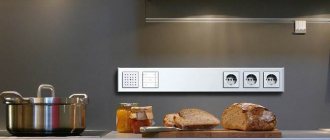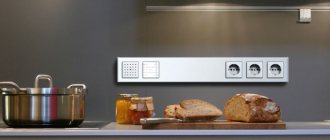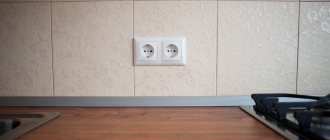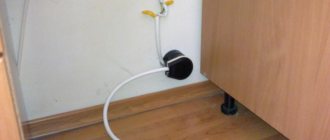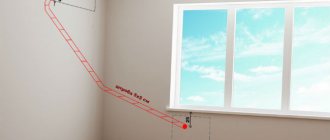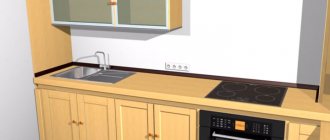The kitchen is the main place in the house for preparing food, and additional appliances that are powered from the mains help simplify the process. Electricity is considered a dangerous form of energy, so safety rules must be followed during repairs and installation. It is important to think through the placement of outlets in the kitchen so that it satisfies all needs. Be sure to take into account the height from the floor, standards for different equipment, the number of lines and other features that you will learn about from this article.
How to properly place sockets in an apartment?
Focus on 1-2 outlets on both sides of the sofa for lighting fixtures and appliances. If there are nightstands near the sofa, plan to place electrical outlets between them and the sofa. Sockets should be at a height of 15-30 cm from the floor, but not higher than the sofa. Many people like to sit comfortably by the window with a book.
Interesting materials:
How to combine cardio and strength training for weight loss? How to create an email for registration? How to create a Google account for a child? How to create a ringtone for iphone in new itunes? How to create a security certificate for a website? How to create a bootable USB flash drive for BIOS? How to save a white item if it has faded? How to save Slime if it doesn't work out? How to sleep with your head where? How to cut cabbage for storage?
Main equipment power
Before determining the installation locations for sockets and proceeding with installation, it is important to perform calculations. The first step is to register all the equipment that is planned to be used, and its approximate power.
The averages are:
- refrigerator - up to 1 kW;
- boiler - from 1.5 kW;
- hob - 1-1.5 kW;
- washing machine - 1.5 kW;
- oven - from 2.5 kW.
The data described applies to large equipment, which creates the main load. Small appliances in the form of a kettle, blender, etc. draw 300–800 W; separate places should be allocated for them in the drawing.
Distance
For free-standing equipment, installation behind the rear wall is also undesirable. If it is necessary to disconnect the plug, you will have to move the large and heavy unit. Even the presence of a built-in defrost mode (in which you can do without removing the plug) is not an argument. Also, in a small-sized kitchen this will create inconvenience - the refrigerator will take up more space due to the impossibility of getting closer to the wall due to the plug. To comply with safety regulations, you will have to turn off the power during a long departure.
A good place to place it is slightly to the side of the refrigerator
The best option is 10-15 cm to the side of the equipment: the socket will be freely accessible, you won’t have to move anything.
General conclusions
Installing kitchen sockets requires additional calculations and the availability of a ready-made floor plan, which indicates where at least the main appliances and furniture will be located. This will tell you how to arrange the socket blocks correctly, and the estimated power of the devices will tell you which of them need to be connected with a separate wire, and which ones can be connected to one line.
The placement of sockets is practically unlimited - they cannot be placed closer than half a meter from the gas pipe and 60 centimeters from the sink. For safety reasons, do not place sockets lower than 15 cm from the floor surface.
In general, in the kitchen you have almost unlimited freedom of action in this matter if you calculate the wiring correctly.
Tags: , automatic, sconce, type, harm, choice, generator, house, , grounding, insulation, cable, like, capacitor, circuit, , marking, installation, power, connection, rule, principle, wire, manufacturer, laying, start , vacuum cleaner, , work, size, calculation, rev, socket, row, garden, system, term, ten, type, current, installation, facade, filter, panel, electrical panel
Access
Many people cannot place it on the side due to the close installation of the kitchen set. In this case, you can “hide” it in a locker.
One option is a hidden socket
A prerequisite is free access to an outlet. To do this, drill a hole in the back wall of the furniture. Please note that with this installation, the level of protection of power supplies must be IP44 or more.
Rules for connecting and installing a freezer on the balcony
Be careful when asking whether you can place the freezer on the balcony in winter to prevent negative consequences associated with the risk of freezer damage or fire.
To ensure reliable installation of the refrigerator, it is recommended to consider the following rules:
- Consult with the property management company in advance to reduce the risks associated with poor condition of concrete slabs on which heavy weights are installed. Otherwise, there is a possibility of their collapse.
- The freezer should stand on a flat surface to prevent performance deterioration due to uneven load on the horizontal surface.
- You only need to connect the device to the power supply directly; using extension cords is inconvenient and dangerous, so you will have to draw an additional line and attach an additional socket to the wall or floor.
- It is dangerous to place the device along the walls, so it is recommended to first check the width of the freezer.
- When installing a small freezer, it is not recommended to use it as an additional seat or table, otherwise there is a risk of its failure.
Take into account all the parameters for installing the camera, so that it will serve for a long time and work properly without causing harm to the apartment or the entire apartment building.
But often the installation of the device will have to be carried out in accordance with the recommendations of the management company or the homeowners’ association, because according to the law, the balcony is partially a common property of the house.
The nuances of operating a refrigerator on the balcony
To maintain the proper operation of the freezer in winter or summer, it is recommended to take into account the rules that help prevent its premature deterioration. The freezer has significant weight, which creates a large load on the concrete slabs, which leads to their collapse. To place the device on a loggia, you should choose lightweight designs.
And also pay additional attention to the glazing of the balcony. For it, you need to use lightweight consumables so that the windows do not have an aggressive effect in the form of additional load on the slabs
To do this, it is better to replace PVC with aluminum material.
Pay extra attention to the serviceability of the equipment, since often its long service life leads to the formation of strong vibration during operation. Because of this, vibration movement has an additional negative impact on the preservation of the condition of the structure, including the load-bearing wall
Be careful when installing a refrigerator or other heavy structures on the loggia to prevent damage to the device or deterioration of the structure of the slabs on which the balcony stands. To do this, you can first consult with the management company to prevent negative consequences.
Kitchen hood
What power do you need for a kitchen hood?
Formula for calculating hood performance:To calculate the power of the hood, in addition to the dimensional parameters of the kitchen, the following values are used:
Hood capacity = height*width*kitchen length*12*1.3 If the kitchen dimensions are 4 m wide, 3 m long, 2.5 m high, then the required hood power will be as follows: 4 * 3 * 2.5 * 12 * 1.3 = 468 m3/hour. |
| Rice. 1. Too lazy to count, a useful table for calculating the minimum performance of a kitchen hood |
The higher the hood power, the faster the air in the kitchen will be renewed and the more comfortable it will be for you to cook.
Which hood to choose for a studio apartment
In a kitchen combined with a living room, preference should be given to a hood that operates in filtration or recirculation mode.
The fact is that if you install a conventional hood connected to a ventilation duct, then no matter how powerful it is, the throughput capacity of the ventilation ducts in most houses is 150–180 cubic meters of air per hour.
Meanwhile, even for a small-sized studio in Khrushchev, you will need a hood with a capacity of at least 400–600 cubic meters.
What is the difference between a recirculating hood and a flow hood:Recirculation-type hoods differ from flow-through hoods in that they do not have an outlet pipe to remove contaminated air into the ventilation shaft; the air returns back to the kitchen through carbon filters. What size should the hood be?The size of the hood is selected based on the size of the slab. In this case, the filter surface may be slightly larger than the cooking surface, but not smaller. From the burners to the hood there must be at least 60 centimeters for electric stoves and at least 75 centimeters for gas stoves.
|
Connection
Once you have managed to connect the refrigerator to the network, you should not fill it with food. Some models take up to three days to enter operating mode.
Once you have managed to connect the refrigerator to the network, you should not fill it with food.
For the technique to adapt, three cycles must pass from its activation. The work cycle includes 10 minutes of work and 20-30 minutes of rest. During the adaptation process, you can monitor and set the options correctly: reduce something or, on the contrary, add something.
For the technique to adapt, three cycles must pass from its activation.
Electrical connection
When choosing a place to install the refrigerator, keep in mind that it operates from an electrical outlet. It is advisable that the outlet be grounded.
When choosing a place to install the refrigerator, keep in mind that it operates from an electrical outlet
The connection stage begins with inspecting the wire and plug, which are secured to the capacitor with tape or twine during the moving process. After installing the unit, the cord is positioned so that it does not have kinks, bends and does not fall under the housing.
The refrigerator connection stage begins with inspecting the wire and plugIt is recommended to connect the power cord to a power outlet using a special power adapter, which protects electrical appliances from voltage surges, extends service life and saves energy.
It is recommended to connect the power cord to a power outlet using a special power adapter
Such a gadget is especially necessary for modern models stuffed with electronics. If there is no ground, you can use an extension cord with grounding and a surge protector.
If there is no ground, you can use an extension cord with grounding and a surge protector.
A refrigerator with an ice maker is a powerful and complex unit that consumes a lot of energy. For its operation, it may be necessary to lay a power cable with a larger cross-section. This connection is made by a specialist directly from the electrical panel to the outlet; grounding in this case is mandatory.
Water connection
The refrigerator with ice maker combines two appliances with cryogenic options. They supply built-in, autonomous and water-connected equipment.
Refrigerator with ice maker combines two appliances with cryogenic options
The refrigerator dispenses chilled water, crushed ice and cubes at the touch of a button. When installing it, it is also necessary to comply with all the above rules and have convenient access to the water supply system.
The refrigerator dispenses chilled water, crushed ice and cubes at the touch of a button.
Here there may be a problem with connecting the refrigerator, since it is necessary to insert a tap with a tap into the cold water supply. To do this properly, you should entrust the work to a specialist.
To do the job properly, you should entrust this task to a specialist.
A tube is laid from the cold water supply to the connection point to the refrigerator. Once a year, change the water purification filter cartridge in the flask. Proper care of this system is described in the operating instructions for the device.
A tube is laid from the cold water supply to the connection point to the refrigerator
Follow the “three levels” rule
You need at least 8–12 sockets in the kitchen (depending on the size of the room and the number of electrical appliances), and they should be placed at three different heights:
Top level:
for a hood, TV and additional illumination of the work surface;
Average level:
for equipment that constantly stands on the countertop (kettle, coffee maker, toaster), or that is connected temporarily (blender, food processor, charger for a phone or tablet, etc.); as well as for appliances that have their own fixed place in the kitchen unit (built-in microwave, column oven). Sometimes a separate refrigerator, freezer and electric stove are connected at the middle level (a special connection is made for it with a special plug).
Lower level:
for built-in refrigerator, hob, oven, washing machine and/or dishwasher.
Please note: in this kitchen in the apron area there are 4 free sockets + an socket for connecting a kettle (it was included in the frame on the left) + its own socket for a microwave and other appliances
Calculate how many electrical appliances you will have and what kind; measure their sizes or, if they have not yet been purchased, check the information on the Internet.
Don't forget that you also need to place an outlet in the area of the dining table or bar counter - preferably a double one.
What extension cord for refrigerator?
Electricians advise using extension cords in which the diameter of the current-carrying core is at least 2.5 mm. To connect the refrigerator, an extension cord with a power of 2200 W or higher is suitable.
Interesting materials:
What role does the central processor play in the system unit? How much of a gift must be declared? How much does the insurance company pay out in case of an accident? What territory does Northern Ireland occupy? What currency to take to Vietnam and how much? What currency is best to take with you to Vietnam? What grout is best to use? What greens can be grown in one bed? What kind of Kazan? What does casein do?
Invite an electrician and order network wiring
When the kitchen design project is ready, you can invite an electrician - and, if necessary, adjust some details on the spot, based on his advice and the state of the electrical network in your home.
Preliminarily, the number of distribution boxes for the kitchen can be calculated as follows: all groups of sockets + high-power appliances (each separately) + overhead lighting.
Also check whether your home has a single- or three-phase network - the type of cable and ampere ratings of the RCD will depend on this (for a single-phase network in the kitchen, a 50 A RCD is sufficient).
There are a lot of appliances in the kitchen, and in order for it to fit perfectly, you need to calculate the location of the sockets in advance
As a rule, for electrical wiring in the kitchen, it is recommended to buy copper cables - they are more expensive, but more reliable (although residential standards allow the use of aluminum ones too). It is safer to choose sockets for the kitchen with a ceramic interior (this is the most reliable dielectric base). It is better to take smooth front panels of sockets and switches - it is easier to remove aggressive kitchen contaminants from such a surface.
In addition, all kitchen appliances must be grounded (in modern homes, the grounding is mounted inside the plug connection: these are metal “antennae” that are visible in the recess of the socket).
Layout
An important issue when planning a kitchen renovation is where sockets are needed and how to position them correctly. Such work should be entrusted to professionals if the owner does not have the appropriate knowledge and experience for independent installation.
First of all, a layout diagram is made with the dimensions and quantity of equipment. For maximum accuracy, you need to determine the layout of where to place the devices.
It is better to identify electrical points even with bare walls - and modern apartments and houses include hidden wiring that is hidden in the grooves. These grooves for wires are made during repairs, since after gating it is necessary to carry out plastering and finishing work.
In prepared gutters, for safety reasons, wires should be laid in corrugation.
Correct placement of sockets and switches is possible after determining the number of devices.
The most popular electrical appliances in the kitchen:
- Oven and stove.
- Kettle.
- Microwave.
- Fridge.
- Hood.
This set is standard, but there may also be a dishwasher, washing machine, TV, and other household appliances. The socket diagram should include all aspects and desires of the hostess.
An approximate plan of sockets and furniture is created taking into account the distances to the main device and the height from the floor or ceiling. It must be taken into account that the wires should not be stretched.
For refrigerator and microwave
There is no specific rule for the height of installation of sockets under a refrigerator or microwave, so the owner or master independently determines the placement according to the type of equipment.
Modern refrigerators are equipped with a cord of about 1.5 m, so the location of the device must be determined in advance. If the outlet is located far from the refrigerator itself, then replacing the cord or the power source itself may be necessary in the near future.
The recommended placement is no lower than 20 cm from the floor level, since the room is characterized by high humidity and the ingress of water can have a negative impact.
A distance above 20 cm ensures insulation of the wires. The optimal value varies between 30–90 cm; this prevents moisture from entering and access will remain free.
For a refrigerator, you need to take into account that it defrosts from time to time, so the power must be turned off. The equipment may move away, but it is better to take this into account in advance and not install an electrical outlet right behind the equipment - this is especially important for a built-in refrigerator.
The optimal solution is to install it to the side on the left or right, and if the cord is long enough, it is possible to place a point above the device.
A refrigerator and microwave can be in the same outlet, but you need to choose the right product. According to the rules, additional equipment for preparing and heating food is placed at eye level , this simplifies its convenience, therefore the height is selected based on this parameter. It can be done in the lower cabinet, and the height from the floor will be approximately 20–75 cm. When installing a microwave in the work area, it is more advisable to place the electric point in the apron.
For hood
Modern kitchens are equipped with an extractor hood, which allows you to remove unpleasant odors from the room. Of course, it also needs an outlet - the optimal placement of the point would be at the top of the room. If you have a headset, it is recommended to power it above it.
There are no specific dimensions from the point to the hood, so owners choose the distance themselves, but it is optimal to make an electrical point near the hood. The installation height from the ceiling is about 15 cm, from the floor 190 cm, and above the work surface about 100 cm.
The described parameters are suitable for any type of kitchen.
For air conditioner
Such equipment is connected directly from a separate cable and machine, in which case an outlet is not needed. In practice, the technique is rarely used, so the electric point is made next to the device. The distance from the ceiling is about 30 cm, but the wire should not be stretched.
Above and below the sink
It is strictly forbidden to place sockets above the sink; however, they can be placed inside the cabinet. For this purpose, moisture-protective types and mandatory connection of lines through an RCD are suitable.
Protected equipment includes covers, rubber seals. The distance from the sink to the outlet should be 50 cm or more. A similar rule applies to pipes.
In addition, the height of the water outlets under the sink is taken into account, which should not be less than 20 cm. Even in the event of a pipe break or flooding, the electrical point will not be exposed to moisture.
For washing machine
The washing machine is often placed in the kitchen, since there is no space in the bathroom, and the water connection point is only in these rooms. Installation is carried out next to the sink, and the connection rules are the same as for a dishwasher.
It is best to install the electric point inside the cabinet next to the sink. This provides protection from moisture. The distance to the device itself is about 10–20 cm, and from the floor 20–40 cm. Be sure to take into account the described dimensions and buy elements that are protected from moisture.
Dishwasher safe
Where to make an outlet for a dishwasher? Let's turn to the safety requirements - they say that switches and electrical points are prohibited at the top or bottom of the sink. This condition applies to any equipment in contact with water.
It is best to make the outlet behind the dishwasher on the left or right, with the maximum distance from the pipes. This increases the degree of security. Installation height 70 cm from the floor.
The ideal place would be the interior of the cabinet, which will protect the network from moisture, and the distance to the equipment will be about 20 cm. A common mistake owners make is locating the point for built-in equipment immediately behind it.
If you use a washing machine and dishwasher up to 4 kW, then you can power them in one line. The point itself must be protected from moisture and supplied with a separate RCD or circuit breaker with a power of 20A. It is best not to turn on both devices at once.
For TV
If you want to install a TV in the kitchen, you will need to decide in advance where to install it. Often the equipment is used during cooking, so installation should be carried out at eye level, although the corner of the room is also suitable.
After choosing the optimal location, a mark is placed on the wall for cutting and installation. With an angular arrangement, it is possible to hide the wires behind the device itself. For TVs, it is necessary to use power sockets, and also provide a TV cable supply.
For stove
The hob and oven, which operate on electricity, must be powered from different sockets that are connected to 2 lines, independently of each other.
The oven is located close to the wall, so the electric point should be installed at a height of about 20 cm from the floor. Based on the power of the equipment, power sockets are selected that can withstand a heavy load. For an oven, 16A is suitable, and types for an electric stove are set at 32-40A.
Furniture is often installed near the oven, so there is no problem in hiding the wires and the outlet itself. It will be internal, you can install it on the back wall of the bedside table, and make a hole for easy access.
It is recommended to make a socket under the stove at a height of 60–70 from the floor.
When using a built-in oven that is placed at chest level, it is recommended that access to electricity be made at a similar level.
It is best to make a point under the equipment or next to it on the left and right. It is important to remember that the distance from the outlet to the gas stove or water supply is 50 cm or more.
Important! It is strictly forbidden to place a point above the stove, and if there are pipes nearby, protective covers or rubber seals must be used.
For work area
An apron in the kitchen is an important detail that is made at surface level for preparing food. Due to this, such a place should include enough electrical points, since small equipment in the form of a combine, coffee machine, kettle, etc. will be powered from them.
The height on the apron for sockets from the top is 15–20 cm or 100–140 cm from the floor. It is not recommended to place them very high so that they do not catch the eye. As a standard, 2 blocks are made on different sides, each of which will have 2-3 points.
If there is lighting in the furniture, the socket is placed at the level of the hood. This arrangement is suitable for a chopper and connecting any devices that the owners use from time to time, and not constantly. An example of placement is shown in the video:
Location of sockets in the kitchen
